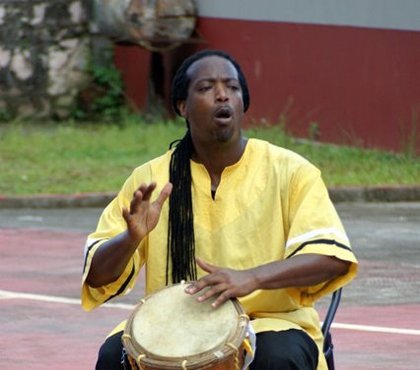The 2013 Smithsonian Folklife Festival begins Wednesday, June 26 and unlike previous years where themes have varied, this year’s cultural gathering will focus on several programs including “The One World, Many Voices: Endangered Languages and Cultural Heritage Program.”
One of the highlight performers promises to be James Lovell, a Garifuna Punta Rock musician from Dangriga Town, Belize who was inspired by the legendary Pen Cayetano.
Lovell has been on a mission to preserve Garifuna, an Arawakan language spoken in Honduras, Belize, Guatemala, and Nicaragua by the Garifuna people. Their language is primarily derived from Arawak and Carib, with English, French, and Spanish to a lesser degree. Organizers of the event said of the nearly 7,000 languages spoken in the world today— many of them unrecorded— up to half may disappear in this century.
As languages vanish, communities lose a wealth of knowledge about history, culture, the natural environment and the human mind. Festival organizers are seeking to help change that.
“Because of the work I’ve been doing to preserve my language, which is a dying language, I use my music as a vehicle to teach the children, the younger generation, through music,” Lovell said. “There are a lot of Garifuna children here in the United States who have no knowledge of their heritage or how to speak the language. I’m trying to help avoid our culture and language from becoming extinct.”
Lovell said that he is also been busy writing a children’s book and creating music that he hopes today’s youth will be able to benefit from.
The Smithsonian Folklife Festival is an international exposition of living cultural heritage annually produced outdoors on the National Mall of the United States in Washington, D.C., by the Smithsonian Institution’s Center for Folklife and Cultural Heritage.
The Festival takes place for two weeks every summer overlapping the Fourth of July holiday. It is an educational presentation that features community-based cultural exemplars. Free to the public, like other Smithsonian museums, each Festival typically draws more than one million visitors, according to organizers.
Initiated in 1967, the Festival has become a national and international model of a research-based presentation of contemporary living cultural traditions.
Over the years, it has brought more than 23,000 musicians, artists, performers, craftspeople, workers, cooks, storytellers and others to the National Mall to demonstrate the skills, knowledge, and aesthetics that embody the creative vitality of community-based traditions.
For Lovell, the selection to participate in the festival was a welcome surprise. “I think the organizers were able to see what I could do by watching links on YouTube and other places,” he said. “I plan to be there until the end of the festival because it’s important that our children and the adults who are children at heart, understand the importance of the Garifuna heritage. The language is something that they need to know about and it is something I’m working hard to try and prevent from dying like others have.”
The festival will include performances, craft demonstrations, interactive discussion sessions, community celebrations, and hands-on educational activities, highly skilled musicians, storytellers, singers, dancers, craftspeople, language educators and other cultural practitioners.
Many will share their artistry, knowledge and traditions while also discussing the meaning and value of their languages to their cultural heritage and ways of life.
Organizers hope that the challenges faced in maintaining the vitality of many languages will also be addressed.
“When a language disappears, unique ways of knowing, understanding, and experiencing the world are lost forever,” Lovell said.
